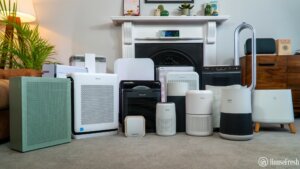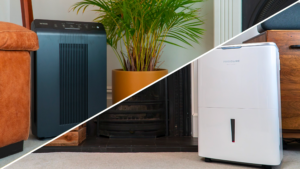
What is an electrostatic air purifier?
Similar to when you rub a balloon on your head, electrostatic air purifiers charge the particles in the air, which then makes these particles easier to remove using magnetic plates.
The charged particles are then removed from the air as they become stuck to the oppositely charged plates. There are two types of electrostatic precipitators, wet ESP and dry ESP. Dry ESP is the type that is primarily used in electrostatic air purifiers, and these use vibrations to remove particles after they have been removed from the air.
Read more about ESP technology at EPA.gov
Most electrostatic air purifiers are used in the industrial process as they require huge devices with significantly sized plates for removing charged particles.
The history of electrostatic precipitators
The technology behind ESP is based on research from Dr. Frederric Cottrell at the University of California, who was the first to patent this technology in the early 20th Century. By 1907, he had a patent for removing sulfuric acid and lead oxide that were being pumped out by nearby factories and destroying the local vineyards.
As with many early technologies discovered, Dr. Cottrell didn’t understand the exact process involved, and it was later discovered in Germany how electrostatic attractions work in practice with particles in the air.
The big issue with electrostatic precipitator air purifiers [home use]
Unlike the mechanical process involved with HEPA, there is a chemical reaction that happens with Electrostatic air purifiers, and there are byproducts generated when you use electricity to charge the surrounding particles. Since 1975, we have known that ozone is generated by ESP technology.
While the amount of ozone is small, the health risks of ozone have only grown with more studies into its effects on asthma and other respiratory diseases.
This risk of ozone is the main reason we don’t recommend this type of air-cleaning technology for home use, as HEPA and activated charcoal can have the same performance with zero byproducts generated.
Other issues with electrostatic precipitator
Unlike HEPA or activated charcoal, pollutants are not trapped inside a filter when removed from the air.
They will build up on the magnetic plates and need to be removed manually, or the filter will become very inefficient and potentially, particles can end up back in the air.
The electrostatic precipitator can remove many different particles of dust, smoke and pollen. But Electrostatic precipitators find it s challenging to remove the tiniest of particles compared to HEPA, which works very well at even the smallest particles, like viruses, due to Brownian motion
Electrostatic precipitators and HEPA
Some air purifier manufacturers use a combination filter that uses electrostatic precipitators to charge particles and increase their weight so they can be more easily removed with a HEPA filter.
Blueair calls it “HEPASilent” and Alen calls it “ionizer,” and when we tested the Blueair 211+ and Alen 75i, we did find an increased efficiency compared to a pure HEPA-based model. Alen uses a similar technology that allows for extra cleaning power without running the fans as high, which also means lower sound levels are created compared to only a mechanical filter process.
We didn’t see any significant increases in ozone with either Blueair or Alen. Still, we appreciate that Alen allows you to disable this process and are disappointed that Blueair doesn’t.
Suppose you want to have zero risk of ozone creation. In that case, you are better off with just mechanical-based air purification technology, and we recently updated our list of ozone-free air purifiers worth considering.








In order to have a clean and green world every individual and business owners should atleast make their living space clean. And I am sure Electronic air cleaners and Electrostatic precipitators will help.
In this polluted world breathing fresh and clean air has almost become very difficult. In such cases its very mandate to have these air sterilizer,electrostatic precipitator, electrostatic precipitator air cleaner needs to be installed.